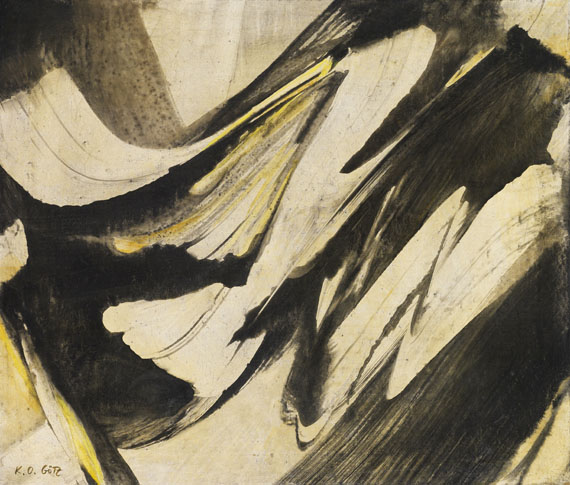385
Karl Otto Götz
Ohne Titel, 1955.
Mixed media on canvas
Stima:
€ 40,000 / $ 42,800 Risultato:
€ 37,500 / $ 40,125 ( commissione inclusa)
Ohne Titel. 1955.
Mixed media on canvas.
Ströher 1955-25. Lower left signed. Signed and dated "6.10.1955" on the reverse. 60 x 70 cm (23.6 x 27.5 in). [SM].
• Karl Otto Götz is among the most important representatives of German Informalism.
• Dynamic gestural work created with the non-painterly device of the squeegee.
• Works from the 1950s ocupy a key position in the oeuvre of K. O. Götz.
• This work has not been offered on the international auction market for 60 years.
PROVENANCE: Private collection France.
Private collection Belgium (gifted from above in 1999).
LITERATURE: Lempertz, Cologne, 467th auction, 1961, lot 200.
"I [tried] to break the constraints of my imagination and to switch off control, in order to lure something anonymous and surprising into the pictore."
(Karl Otto Götz in an interview with G. Bussmann in 1972, quote from: Manfred de la Motte (ed.), K.O. Götz, Bonn 1978, p. 42).
Mixed media on canvas.
Ströher 1955-25. Lower left signed. Signed and dated "6.10.1955" on the reverse. 60 x 70 cm (23.6 x 27.5 in). [SM].
• Karl Otto Götz is among the most important representatives of German Informalism.
• Dynamic gestural work created with the non-painterly device of the squeegee.
• Works from the 1950s ocupy a key position in the oeuvre of K. O. Götz.
• This work has not been offered on the international auction market for 60 years.
PROVENANCE: Private collection France.
Private collection Belgium (gifted from above in 1999).
LITERATURE: Lempertz, Cologne, 467th auction, 1961, lot 200.
"I [tried] to break the constraints of my imagination and to switch off control, in order to lure something anonymous and surprising into the pictore."
(Karl Otto Götz in an interview with G. Bussmann in 1972, quote from: Manfred de la Motte (ed.), K.O. Götz, Bonn 1978, p. 42).
Around 1949 Karl Otto Götz broke away from representational art and joined the "CoBrA" artists' association. In 1953, under the influence of Wols and French Tachism, he began to paint the series of pictures that made him one of the most important representatives of German Informalism. But his art occupies a special position in the broad spectrum of informal art. Götz’s pictures are characterized by the dissolution of the classic form principle. Movement is one of the defining elements in his painting. Although his pictures made in a quick gesture that combines automatism and control, each one is based on an abstract scheme. Above all, the technique used was decisive for the creative process. "When I was mixing paint for my little son in the summer of 1952, I found my quick painting technique almost by accident: put the paste on the paper, then add the gouache, and the picture was finished [.] The step from cardboard (gouache) to canvas came about by itself. So in the winter of 1952/53 I found the technique and concept that should henceforth determine the structure of my pictures [.] "(quote from: H. Zimmermann, in: Ex. cat. Staatliche Kunstsammlungen Dresden et al, 1994, p. 12). From 1953 onward Götz developed his pictures in a three-stage process. In a first step, Götz applied thin fluid paint to the image carrier spread out on the floor. After a short concentration, a second decisive step follows: the treatment of the wet paint with a squeegee. Through the employment of the squeegee - depending on the image format, he used brush and squeegee in different sizes of up to a width of one meter – he created a negative in places of the positive of the color trail, the light texture of which merges with the background. In a third step Götz uses the dry, "empty" brush to combining positive and negative passages. What is most characteristic are the strong impetus and the verve, which make it difficult to define what is movement, what is space, or the scope of automatism and control. In his artistic concept of movement, positive-negative forms and the color’s font character, calculation and emotion, rationality and spontaneity are in balance. The artist's works are always based on a certain abstract scheme. Such a scheme, prepared in mind or in many small sketches and gouaches, provides the framework of the picture, directions and mass distributions. Once the compositional framework has been found, chance has no limits. The result is a work that, in its dynamic expression, documents the speed and movement of the creative process behind. A process so unique that it makes Karl Otto Götz a classic of abstraction. [SM]
385
Karl Otto Götz
Ohne Titel, 1955.
Mixed media on canvas
Stima:
€ 40,000 / $ 42,800 Risultato:
€ 37,500 / $ 40,125 ( commissione inclusa)




 Lot 385
Lot 385 